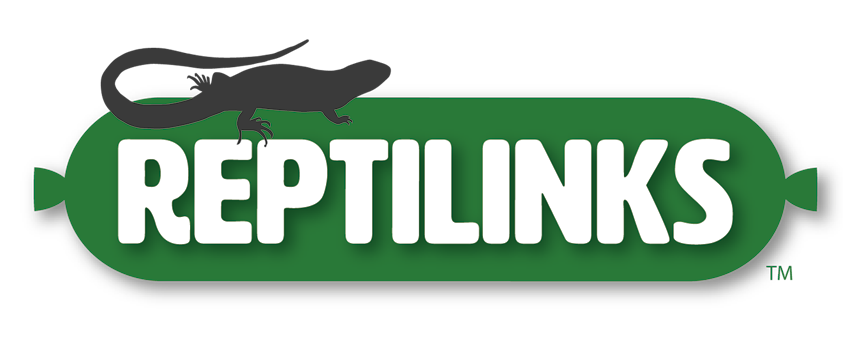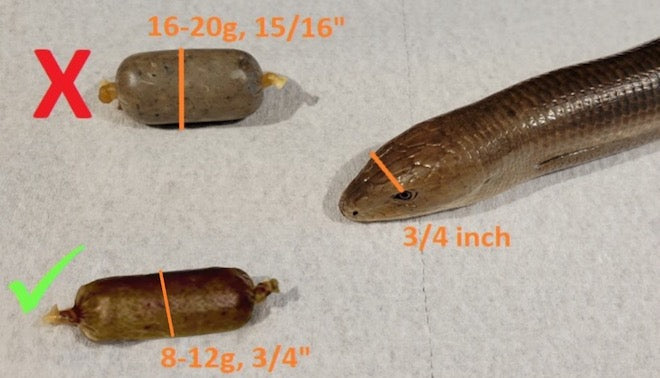Reptiles come in all shapes and sizes—and with so much variance, figuring out how much to feed them can seem just as complicated as rocket science. Correctly portioning food for your scaly friend is about more than just your budget; while it’s true that you’ll save money if you don’t overfeed, you’ll also be investing in a long and healthy life for your animal.
Feeding an incorrectly sized food item can contribute to obesity, as your reptile will take in more calories than they burn. As fat collects around vital organs over time, it places strain on those organs, which work harder to perform their basic functions. This can shorten the lifespan of your snake or lizard and make them uncomfortable or ill.
So how do you figure out the right size for a food item? There are a few methods, and using all of them together will give you the tools you need to accurately calculate the measurements of an appropriately sized food item. Here’s what you need to know.
First of all, Reptilinks come in the following sizes:

The Comparison Method
The most common (and perhaps most easily used) method of determining how big a food item should be is the comparison method. Using this strategy, carefully examine your reptile. If it’s a lizard, note the distance between its eyes across the top of its head. A food item such as a Reptilink or whole prey animal should not exceed the distance between your lizard’s eyes. In other words, make sure your food item is narrower than the space between your animal’s eyes. Otherwise, it’s too big, and your lizard could choke. Odds are, if you’re feeding something that is overly large, you’re also providing too many calories—which means that getting this right is beneficial in multiple ways!

In the image above, we see a blue tongue skink considering two different sizes of Reptilinks. Because the distance between the skink’s eyes is one inch, it’s safe to feed him either a 15/16 inch link or a 3/4 inch link.

However, the sheltopusik in the image above does not have the same choices. Because the space between her eyes is only ¾ inch, the link that is almost one inch wide is too large for her.
This tactic also works with snakes, but you’ll be comparing a different area of the body. A snake’s head isn’t a very good indication of how big of a meal it can eat. After all, their jaws can expand! Instead, the comparison method for snakes doesn’t rely on the eyes and calculates based on the width of the body.
Locate the widest part of your snake’s body. That’s likely right in the middle. Any food item should be smaller than this area in width.

Because this ball python is 2 inches wide at her largest point, she can comfortably eat an item of approximately one inch, like this link. In fact, she could safely move all the way up to Reptilinks’ larger sizes, such as a 1.25 inch 75g link!
The Calorie Method
Now that you have a generalized idea of how big of a food item or Reptilink your animal can safely tolerate, consider how many calories it provides. In broad terms, feed no more than 10-15% of your animal’s weight in each feeding. Keep in mind that proteins and fats contain more calories than vegetation. Reptilinks are more calorie dense than whole prey, so they can be fed less often—which saves your pocketbook the expense of buying food quite so frequently. Above all, remain alert for signs of obesity in your reptile; those will be covered later on.
The Mechanism of Eating Method
Finally, you can further refine your food selection by considering the mechanism of eating that your reptile relies on. Say you have a tegu, and you’d like to feed a Reptilink that is exactly the same size as the space between their eyes. You’re unsure whether this is a little too big. To figure out what to do, think about how tegus eat.
Tegus (and most other lizards) have powerful jaws that can bite down on food items. Depending on the species, your animal may be able to chew, tear, crush, or mash their food. If this is the case, your animal can tolerate foods that are on the upper edge of the size criteria, because they will be able to break them down into manageable pieces. Since Reptilinks are designed to be swallowed whole (thus reducing mess), it may make more sense to stay on the smaller size and feed multiple links If necessary, particularly for lizards.

This black and white tegu is able to mash the link with its powerful jaws, reducing its size and making it more manageable to eat.
Snakes, on the other hand, eat in a completely different way. They must expand their jaws to fit a food item whole, no chewing involved. If they cannot adequately open their mouth, or if the item is too large, they may regurgitate it. Worse yet, if it’s large enough to block their airway as they swallow, they could suffocate. Because their mechanism of eating is more sensitive to absolute food item size, it is recommended that you avoid feeding an item that is close to the top margins of their maximum possible food size.
Using a combination of body comparison measurement, eating method considerations, and calorie/obesity attention, you should be able to land on a size that is right for your scaly friend.
The Body Weight Method
Sometimes, an animal might have a uniquely shaped mouth, or other constraints might make it difficult to use the previously mentioned methods on their own. This is when the body weight method can come in handy! Reptilinks and other food sources like whole prey should typically be between 10% and 15% of an animal’s body weight to prevent overfeeding. This means, even if the link is the appropriate size, if you feed multiple links in a single feeding, you may exceed this body weight guideline and have more of a chance of regurgitation. The body weight method can also be helpful If you’re chopping up food items, as this can be a useful metric in lieu of mouth size and shape!
Pay Attention for Signs of Obesity
Reptiles rely on their keepers to stay healthy and get the nutrition they need. If you’ve done the calculations and are feeding your reptile according to the size that is right for them, that doesn’t mean your job is done. Going forward, be sure to remain vigilant for signs of obesity. It is entirely possible to feed a reptile appropriately sized food but in too great a quantity or too frequently.
How do you identify an obese reptile? This will look different on a species-specific basis, but there are some overarching signs that are true for many herps no matter their variety.
Bloat
An animal that appears to have tight skin, especially around its belly and vent areas, may be overweight. These are some of the first regions to expand when excess fat is stored in many reptiles. For snakes, this will often manifest as a lump on either side of the vent rather than a smooth, gradual transition down to the tail. It can also look like excessive wrinkling or rolls. Some animals, such as tegus and many monitors, will lose the line of loose skin along their sides when they become overweight.

This ball python is getting close to being overweight. The vent area before the yellow tail markings is wrinkling, with a minor bulge on each side of the vent indicating that some fat has begun to store there. However, her spine still creates a notable peak, so her weight gain is still in the very early stages. It’s time to add one more week between feedings!
Segmentation
If your reptile appears to be made of many segments rather than one smooth body shape, it could be storing fat in joining areas such as the neck and base of the tail. This often makes lizards look like their heads are too small for their bodies.
Sunken Spine
Many lizards and snakes will experience a regression of their spine when they become overweight or obese. It might seem like their spine is indented into their back, creating a valley rather than standing up like a ridge. This is because fat is accumulating along their back, lifting the skin up until it is higher than the spine. Gently pressing on the area to either side of the spine may reveal a soft, fatty texture rather than one that is firm and muscular.
What to Do
If you believe that your reptile is obese, this problem is reversible. Obesity happens when a reptile is eating more calories than it burns. This means that you have multiple options. You can exercise and enrich your animal more often to increase the calories they burn every day. If your food item size is correct, consider spreading out feedings; maybe instead of eating once per day, your reptile eats once every other day. Alternatively, offer less food at each sitting. Over time, you will begin to notice gradual changes in your reptile as their body converts excess fat into energy and excretes the rest. This will leave them healthier and happier!
The Potential for Underfeeding
In an effort to carefully portion your reptile’s food, you may end up feeding them less than they need. The simplest way to identify an underfed reptile is to understand what a healthy specimen looks like for comparison. If your scaly friend is lethargic, shy, or unwilling to engage—and this behavior is unusual for them—this could signal that they are lacking the calories they need to invest energy in activity.
Pay attention to the bone structure of your animal as well. Underfed individuals may lack important resources such as calcium, which can cause fingers and tails to take on a bent, soft, or irregular shape. Visible ribs, hip bones, and spinal features may also be a cause for concern and should be compared to a healthy animal. Most of all, keep track of your animal’s weight. If it continues to decrease over time (and you are not facilitating a weight loss diet as a treatment for obesity), consider gradually adding slightly more food or feeding more often. Supplementing with Reptilinks can help, because they are calorie dense compared to similar food items!

